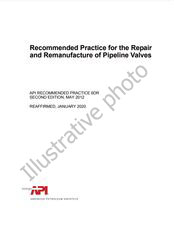We need your consent to use the individual data so that you can see information about your interests, among other things. Click "OK" to give your consent.

API PUBL 303-ed.1992
Generation and Management of Wastes and Secondary Materials
Translate name
STANDARD published on 1.6.1992
The information about the standard:
Designation standards: API PUBL 303-ed.1992
Publication date standards: 1.6.1992
SKU: NS-1139700
The number of pages: 115
Approximate weight : 376 g (0.83 lbs)
Country: American technical standard
Category: Technical standards API
Annotation of standard text API PUBL 303-ed.1992 :
API PUBL 303, 1992 Edition, June 1992 - Generation and Management of Wastes and Secondary Materials
Four yearsago, API began chronicling the generation and management of wastes and secondary materials in the petroleum refining industry. Recognizing that one-time data collection would provide a snapshot that could not be used to reliably assess progress, API committed to analyzing at least four consecutive years of data.
In February 1991, the first two years of data were compiled and published in The Generation and Management of Wastes and Secondary Materials in the Petroleum Refining lndusfry 1987-7988 (API publication number 849-30000). This report on 1989 data continues the series. Data for 1990 are now being collected and will be published separately.
The scope of the survey is broader than the Resource Conservation and Recovery Act (RCRAj regulatory definition of solid waste. API has collected data on a variety of materials, including hazardous and non-hazardous wastes and secondary materials sometimes considered byproducts or recyclable materials. The rationale for including both wastes and secondary materials in the survey is to characterize -- and quantify -- the non-fuel materials the refining industry generates and manages. Previous data collection efforts -- by regulatory agencies and the industry itself -- focused only on certain wastes; the resulting lack of comprehensive information impaired advocacy efforts and slowed the planning of pollution prevention initiatives.
The primary goal of the survey is to track the management of wastes and secondary materials from the point of generation. API, has incorporated an integrated waste management hierarchy in the data collection forms -- classifying waste handling practices as source reduction, recycling, treatment or disposal. This conceptual framework acknowledges that, a range of practices is needed to handle wastes, and that some practices are more desirable than others. It may ,also help the industry and individual refineries assess progress over time both in reducing the, amount of waste generated and in handling those that remain in an environmentally sound manner.
The survey is an ambitious undertaking. In the area of waste -- where conventional wisdom holds that smaller is better -- a large industry essentially asked, "How much?" Petroleum refineries process some 15.7 million barrels of crude oil per per day -- 5.7 billion barrels or 650 million tons per year. Even if the waste from each barrel is small, the sheer volume results in a large number.
By amassing several years of data in an effort to create a reliable baseline, the industry risks being asked a second question, "How much less?" Here, the variability inherent in refineries operating practices works against early detection of incremental progress in reducing wastes. One-time events such as turnarounds or shutting down surface impoundments create peaks in waste volumes that can mask the progress better management practices and source reduction activities achieve.
Simply by conducting the survey, API, invites a third question, "What does it mean?" While many quantitative observations can be explained particularly where there are strong trends -- the reasons why other numbers increase or decrease are more elusive. Though some may never be entirely clear, additional measures over an extended period of time, may identify more factors that influence generation rates and the magnitude of their effects.
Individual refineries have already reported that they find the survey a useful accounting tool for classifying and quantifying wastes. Having characterized their wastes, they may go on to compare themselves to the industry as a whole and target areas where change is needed. The aggregated survey data also provide a context for evaluating the impact of new regulations and reporting requirements. Though it takes two to three years tp amass the data, APIs information is more current and comprehensive than any other waste management database. Thus, the survey can also provide more reliable estimates of the impact of proposed regulatory changes.
We recommend:
Technical standards updating
Do you want to make sure you use only the valid technical standards?
We can offer you a solution which will provide you a monthly overview concerning the updating of standards which you use.
Would you like to know more? Look at this page.



 Cookies
Cookies
